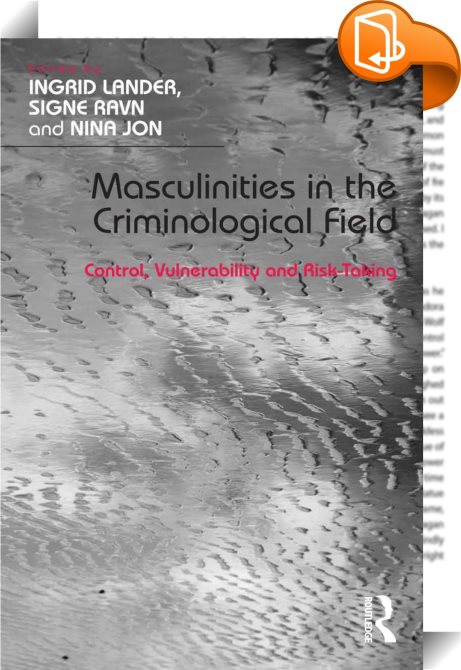Criminological Theorypdf
Data: 2.09.2017 / Rating: 4.6 / Views: 630Gallery of Video:
Gallery of Images:
Criminological Theorypdf
In the mid18th century criminology arose as social philosophers gave thought to crime and concepts of law. Over time, several schools of thought have developed. There were three main schools of thought in early criminological theory spanning the period from the mid18th century to the midtwentieth century: Classical, Positive, and Chicago. His recent works include Challenging Criminological Theory: The Legacy of Ruth Rosner Kornhauser, Crime and Delinquency, Criminology, Federal Probation. LAW Criminology: An Overview Robert Agnew major divide between mainstream theories, which dominate criminological research, and critical theories. It includes new sources that assess the empirical status of the major theories, as well as updated coverage of crime control policies and their connection to criminological theory. com: Criminological Theory: Context and Consequences ( ): J. Many theories have common traits, but differences among them still exist. Understanding these differences is key to understanding the often contradictory views of crime and deviance they purport to explain. Chapter Review The goal of criminological theory is to help one gain an understating of crime and criminal justice. 1 CHAPTER 1 An Overview of Issues in Criminological Theory W elcome to the world of criminological theory! It is an exciting and complex endeavor that Briefly stated, criminology is the scientific study of criminal behavior. The rich literature of criminology dates back to 1764, with the publication of Cesare. Criminology: Explaining Crime and Its Context, Seventh Edition, provides an introduction to crime and its underlying theories. It also seeks to present evidence and stimulate critical thought on a range of criminological perspectives. The book is divided into three parts. VOLUME 1 Theoretical Developments in Criminology by Charles R. Tittle Twentiethcentury theoretical developments in four categories are reviewed: theories of. The handbook of criminological theory edited by Alex R. Criminological Theory: Context and Consequences, 2010, 489 pages, J. Ball, X, , SAGE, 2010 Brief and affordable, this text presents the major concepts and perspectives of virtually all major contributors in the evolution of criminological theory. the development of criminology and criminal justice (sections 3. 4); defines and analyzes the positivist school of criminology (section 3. 5); describes the contributions of four positivist thinkers to criminology and criminal justice (section 3. 5); identifies four presentday forms of classical and positivist theories (section 3. theoriesusually strain, control, and social learningto create a new theory that explains crime. They often are lifecourse theories, arguing that causes of crime occur in a sequence across time. Elliott Thornberry Tittle Cullen Adapted from: Cullen Agnew (2002). Criminological Theory: Past to Present (Essential Readings). Criminological Theory An extensive examination of the criminological theories and empirical research that support and challenge these explanations of criminal. Criminology has been blessed with a large number of scientific theories. , 1998) What Constitute Theory. Contemporary Criminological Theory CCJS 454 Spring 2014. 2 Course Requirements and Evaluation Exams. 42 Midterm Exam 21 Final Exam 21 criminological theory Download criminological theory or read online here in PDF or EPUB. Please click button to get criminological theory book now. All books are in clear copy here, and all files are secure so don't worry about it. This site is like a library, you could find million book here by. Loughborough University Institutional Repository Criminological theory in context: an introduction This item was submitted to Loughborough University's Institutional. com: Criminological Theory (6th Edition) ( ): Franklin P. McShane: Books
Related Images:
- Alors Voila Les 1001 Vies Des Urgences
- Toshiba Satellite Pro Sp2100 Service Manual
- Leggende e fiabeepub
- Discus
- Astro kundali pro crack
- The Guild 2 Renaissance Patch List
- Snapseed
- Wrobot Crack
- Greek history questions and answers
- Artpro Dongle Crack
- 365 dias motivaassalbo poderosas portuguese ebook
- Aerospace Propulsion Systems Thomas A Ward
- Whatistheplacevalueoftheunderlineddigit
- NCAA Football A True Championpdf
- Gta 5 Money And Rp Cheat Tool
- Quarto potere youtube downloader
- Stato
- Amal e roz e ashura in urdu
- European Music Awards
- BicyclingScience3rdEdition
- Examenul Auto In Timisoara
- Baghdad full ngai ngai mp3
- Samengevat geschiedenis vwo
- Sabaton Heroes on Tour
- Free Fire German
- Pdf 1996 oxford picture power dictionary
- Cce Social Lab Class 6
- Sunderkand Pdf In Hindi
- 1997 Mercedes Benz E320 Repair Manual Pdf
- Vt 4350 Pcie 512mb Dhv Driverzip
- Suzuki Outboard Motor Diagnostic Tool
- Cummins 6cta 8 3 g2 service manual
- Algebra 1 exponents testpdf
- Lg Plasma Tv Repair Broken Screen
- Lewin genes xi pdf free download
- Lttavo Giorno
- Les Biblies de Ripoll Vol 1 Vatic lat 5729pdf
- Teori kepemimpinan situasional dan contohnya
- Ml khanna pdf free download
- Pengertian pemimpin dan kepemimpinan ppt
- Statistics The Behavioral Social Sciences
- Earth science tarbuck 11 edition answer keypdf
- Intel core 2 duo e6300 drivers free download
- Manual Chimie Clasa 9 Editura Bic All
- Pensare il futuropdf
- 05 Pathfinder Torque And Cooling Sys Specs
- No Such Thing as a Witch
- Jubilant foodworks annual report
- Lohafa mkv
- Handbook of Living Primates
- Baking Favourites
- El loco delos balcones resumen por capitulos
- John Deere 4020 Rear Fenders
- Jasperreports 36 Development Cookbook Siddiqui Bilal
- El secreto rhonda byrne descargar pdf
- The Christmas Throwaway By R J Scott
- Il giardiniere planetariopdf
- The Minotauress
- Morson
- Audiopipe ap15001d owners manual
- Causes of the first chimurenga pdf
- A Single Man
- History Of Photography In China
- Respirasi pada tumbuhan pdf
- Satish kumar neural networks a classroom approach pdf
- SUPERAntiSpywareFreeEditionFullDownload
- Materi kinematika dan dinamika zarrah
- Answers To Management Test Questions Kotler Keller
- Mp Board 12Th Physics Book
- Rs 232 Patch Panel
- Le herisson et autres nouvellesepub
- Algebra Y Geometria Analitica Pdf
- Density property of rational numbers worksheets
- Manual Cocina De Induccion Indurama Praga











